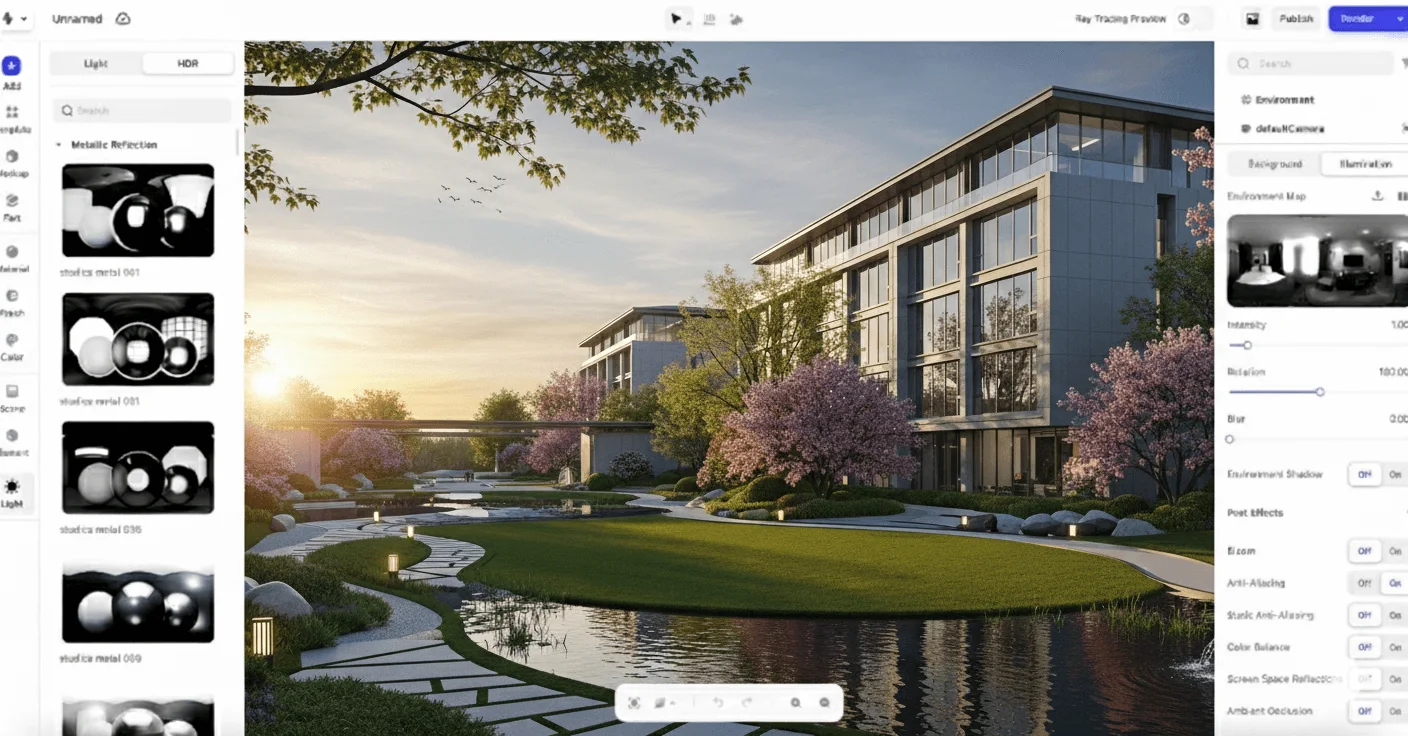For decades, the life of a 3D artist has been defined by a single, agonizing action: waiting. We’d tweak a light, adjust a texture, and then stare at a progress bar, hoping the noisy, pixelated preview that emerged would be close to what we imagined. Creativity was a slow, frustrating game of guesswork.
That game is now over.
A revolutionary technology has arrived that closes the gap between imagination and execution, between a creative impulse and a photorealistic result. It’s called real-time ray tracing. It replaces the slow, painful "render and wait" cycle with a fluid, interactive, and joyful dialogue between you and your work. It's the most significant leap in a generation, and this guide will explain, in simple terms, how it works and why it changes everything.
What is Real-Time Ray Tracing? The Simple Answer
In the simplest terms, real-time ray tracing is a rendering technology that simulates the true, physical path of light in a virtual scene—creating perfectly realistic lighting, shadows, and reflections—at a speed so fast that you can interact with the scene live, as if it were a video game.
Why does this matter? For the first time, it completely eliminates the painful trade-off that has defined 3D graphics for thirty years. Artists no longer have to choose between the interactive speed of a simple preview and the photorealistic quality of a final render. With real-time ray tracing, you finally get both. Simultaneously.
The Tech Behind the Magic: From Video Game Tricks to Movie Magic
To understand this breakthrough, you need to know about the two older technologies it has brilliantly fused together.
The Old Way #1: Rasterization (The Video Game Trick)
For years, video games have given us beautiful, interactive 3D worlds. They did it with a clever system of "faking it" called rasterization. Instead of simulating real light, it uses brilliant shortcuts to approximate how shadows and reflections should look. It’s incredibly fast, but it's not physically accurate. The reflections are often distorted, and the shadows lack true softness.
The Old Way #2: Offline Ray Tracing (The Movie Magic)
On the opposite end is the method used for Hollywood VFX. Traditional ray tracing is a purist's approach. It's a "detective method," meticulously tracking the path of millions of virtual light rays as they bounce, refract, and reflect through a scene. A single frame can take hours, but the result is perfect, physically accurate realism.
The Breakthrough: Real-Time Ray Tracing (The Best of Both Worlds)
The miraculous arrival of real-time ray tracing is the result of powerful new graphics cards (GPUs) and smarter software (using AI denoising) working in perfect harmony. This fusion allows the slow, meticulous "movie magic" method to run at the blazing "video game" speed. You are literally painting with light in real-time.
What Real-Time Ray Tracing Feels Like in a Workflow
The technology is one thing. How it transforms your daily work is another. It feels like unlocking a new creative sense.
 Creative Flow, Uninterrupted: You grab the virtual sun and drag it across the sky, and you watch as photorealistic "god rays" slice through a window and pivot across the floor, live. The technical barrier between your idea and the screen simply dissolves.
Creative Flow, Uninterrupted: You grab the virtual sun and drag it across the sky, and you watch as photorealistic "god rays" slice through a window and pivot across the floor, live. The technical barrier between your idea and the screen simply dissolves. Confident Decisions, Instantly: You swap a material on a product design from matte plastic to brushed aluminum to polished chrome and see, instantly, exactly how the real-world reflections and highlights will behave. Guesswork is replaced by immediate, accurate feedback.
Confident Decisions, Instantly: You swap a material on a product design from matte plastic to brushed aluminum to polished chrome and see, instantly, exactly how the real-world reflections and highlights will behave. Guesswork is replaced by immediate, accurate feedback. Game-Changing Client Meetings: Your client asks, "That looks great, but what would it feel like at sunset?" Instead of promising a new render by tomorrow, you drag the sun down to the horizon and show them, as the virtual room is bathed in a perfect, golden light. It’s a moment of magic that accelerates project approvals like nothing else.
Game-Changing Client Meetings: Your client asks, "That looks great, but what would it feel like at sunset?" Instead of promising a new render by tomorrow, you drag the sun down to the horizon and show them, as the virtual room is bathed in a perfect, golden light. It’s a moment of magic that accelerates project approvals like nothing else.
 A stunning architectural render showcasing the complex, realistic lighting and reflections made possible by real-time ray tracing.
A stunning architectural render showcasing the complex, realistic lighting and reflections made possible by real-time ray tracing.
The New Frontier: Real-Time Ray Tracing in Your Browser
Until very recently, there was a huge catch. To access this power, you needed an incredibly expensive, high-end desktop computer with a specific, top-of-the-line graphics card. It was a privilege reserved for those with the deepest pockets.
That final barrier is now being demolished.
Platforms like Realishot are democratizing this immense power by moving the entire workload from your local machine to the cloud. With a cloud-native platform, you get all the jaw-dropping benefits of real-time ray tracing but without the five-thousand-dollar workstation or the complex software installation. Your MacBook Air or a simple office PC becomes a window to a virtual supercomputer.
This revolutionary online-first approach is redefining what is possible for creative teams. We explore it in depth in our review of the best online 3D rendering software.
Who is Using Real-Time Ray Tracing Right Now?
This isn't a future technology; it’s here, and it’s reshaping major industries by enabling speed and realism simultaneously.
 Product Concept Design: Industrial designers can now iterate on dozens of material and lighting concepts in a single session, dramatically accelerating the path from idea to a "looks-like" final prototype.
Product Concept Design: Industrial designers can now iterate on dozens of material and lighting concepts in a single session, dramatically accelerating the path from idea to a "looks-like" final prototype. E-commerce & Marketing: Brands are creating stunning, studio-quality product visuals for their online stores and advertising campaigns without the time and expense of traditional photoshoots.
E-commerce & Marketing: Brands are creating stunning, studio-quality product visuals for their online stores and advertising campaigns without the time and expense of traditional photoshoots. Architectural Visualization: Firms are creating fully interactive, photorealistic walkthroughs of unbuilt buildings, allowing clients to experience a space before a single brick is laid.
Architectural Visualization: Firms are creating fully interactive, photorealistic walkthroughs of unbuilt buildings, allowing clients to experience a space before a single brick is laid. Video Games: It's the driving force behind the incredible realism of the latest generation of games on PlayStation 5, Xbox Series X, and high-end PCs.
Video Games: It's the driving force behind the incredible realism of the latest generation of games on PlayStation 5, Xbox Series X, and high-end PCs.
Conclusion: More Than Just a Feature, It’s a New Conversation
Real-time ray tracing is more than just a cool feature on a product's spec sheet. It represents a fundamental shift in how we create. It closes the painful gap between a creative idea and its execution, transforming a slow, frustrating monologue of "render and wait" into a fluid and joyful dialogue between the artist and their art.
The era of guessing is over. The new era is one of instant feedback and fluid creation. Platforms that embrace this technology—especially those that make it accessible to everyone, everywhere, in a simple web browser, like Realishot—are not just offering a better feature; they are offering a better way to bring ideas to life.
